Originally Published on SEMrush October 30, 2018 (Jason Barnard)
Reminder from (this article): brand SERPs are vital touch-points for both people and machines and are therefore absolutely essential to your business.
For any query containing your brand name, you would ideally want results that:
- Reflect your brand message.
- Are consistent with up-to-date information.
- Shed a very positive light on your brand.
Like many of us, you may believe Google shows accurate, consistent and positive information to prospects, investors, partners, clients, journalists, job candidates, readers, subscribers, etc. who search your brand name. Wrong.
Even if your brand SERPs are reasonably accurate, they can and should be improved. Strive to make them perfect. This article makes a very good case for this.
Perhaps before reading the rest of this article, you should:
Check your brand SERP
(use incognito mode in your browser).
That SERP may be good, bad or anywhere in-between. But it is not perfect. Seize the opportunities to improve.
What does a bad Brand SERP look like?
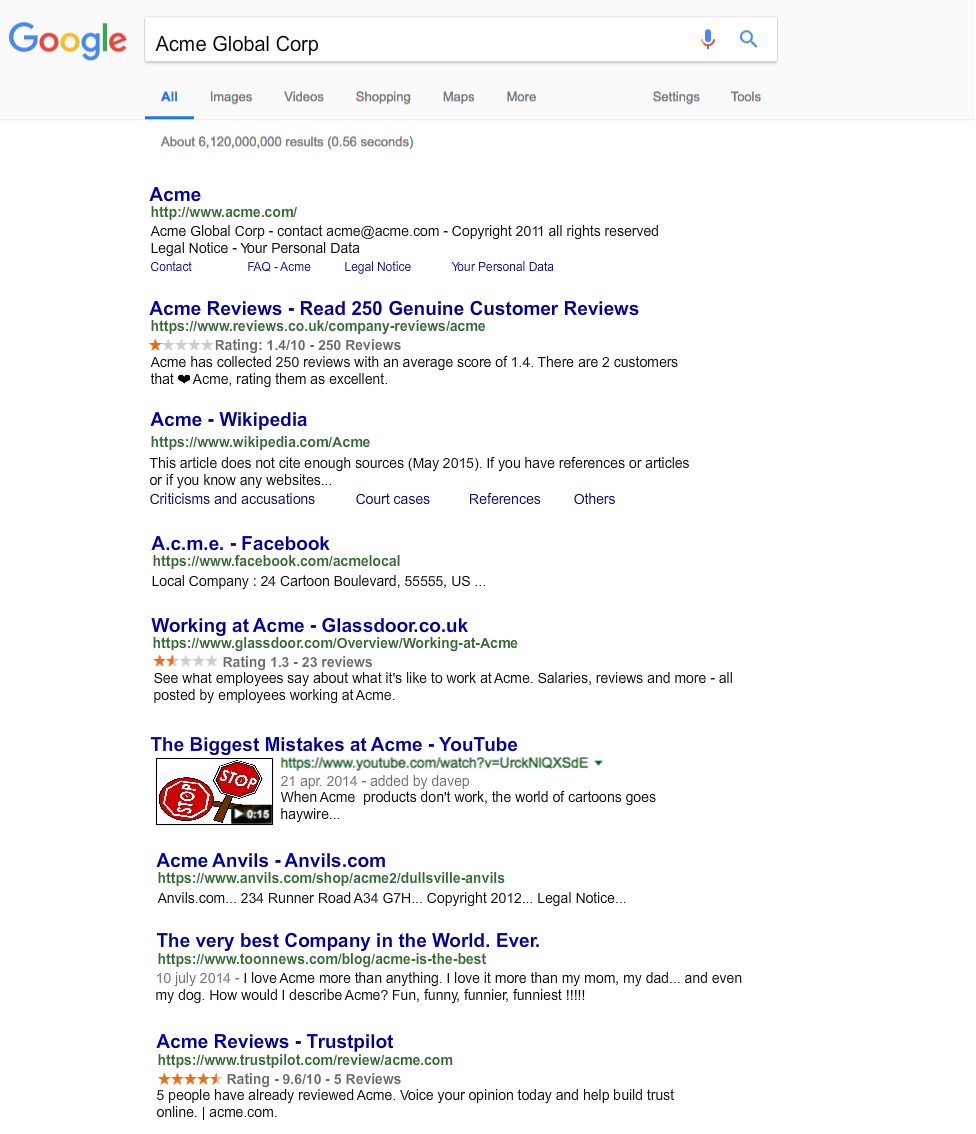
There are all sorts of issues in this SERP (aside from the obvious big red stop sign, and the very bad reviews in second and fifth place). This SERP is:
- Inaccurate
- Negative
- Unconvincing
- Uninspiring
- Incomplete
And there is no reason for it to be like that! Acme could (and should) work to make their brand SERP perfect (the resulting, perfected SERP is at the bottom of this article).
The simplest way to approach the task of influencing these SERPs in your favor
Every URL / result that appears in a brand SERP can be placed into one of three categories:
- Direct control
- Indirect / partial control
- No control
So, we do not approach this list of 9 URL from top to bottom. We address it by the level of control we have.
Direct Control
This part is easy, but it is surprising how many brands fail to optimize and standardize the SERP results they control.
Example site suggestions:

- Update the homepage meta title.
- Add a meta description to the homepage (there is none, Google is pulling text from the footer of this site).
- Write perfect meta titles and meta descriptions of all pages that may appear as sitelinks, including (but not limited to): contact, client login, about us, jobs, FAQ, categories, products, etc.
- And noindex the legal pages; they serve no purpose as sitelinks, or to potential clients searching on Google.
- Move to SSL (small point, but users are coming to expect that).
Although seemingly ‘détails’, 3 and 4 above will contribute to getting rich sitelinks. Rich sitelinks look great, are helpful to users, and will reduce the number of results that appear on the first page; this is more meaningful than it might at first appear. It doubles the real estate you control directly with the first result. Plus, having 8 results to control rather than 9 means less work for you.
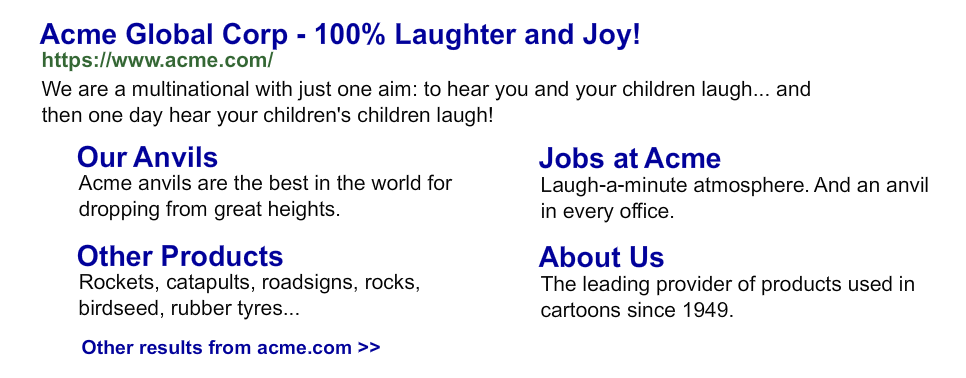
Social Media Accounts

The above example is Facebook. It could be Twitter, Instagram, LinkedIn, YouTube or any other social platform that is powerful in your sphere. For these social channels, some of what is shown in the SERP is branded content imposed by the social channel. Remember, you control the rest. Healthy, active official social accounts tend to rank well on brand searches. These are easy wins.
- Update the social account title and description (that display in the SERPs) with something that is both attractive in the sphere of social media, but also that projects a message that is consistent with your site.
- Ensure the slug (in this case acmelocal) reflects your brand message.
- Depending on the platform, get positive reviews from happy customers.
- Ensure you keep feeding the channels you choose.

Indirect / Partial Control
Job sites

Job websites appear surprisingly often in brand SERPs. Some job sites have a powerful SEO présence and rise to the top. Often with bad reviews from unhappy ex-employees.
As a general rule, you do not want these sites on your brand or brand review SERPs. However, this is something you need to deal with. Aside from potentially making your brand SERPs prettier, potential employees do consult these sites, just as potential clients consult brand and product review sites.
- Claim your page on the job sites that appear.
- It is very rare that you can change the title or description that appears in the SERPs, but if you can, do so.
- Get positive reviews from happy employees and ex-employees. Doing so is very delicate, and each case has unique issues, so it is impossible to give general advice on how to do this. Rule of thumb for scores to aim for: 3 to 4 on job sites.

Customer Review Sites
Start with those that appear on pages 1 and 2 on brand searches. Google sees these as representative and is showing them to your potential clients. It doesn’t matter whether you feel the platform is legitimate, or fair, or reasonable; if they appear on SERPs related to your brand, you need to deal with them.
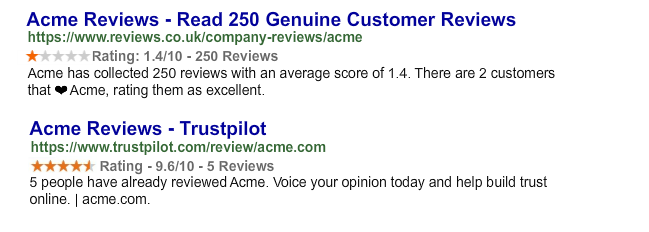
- Always take control of the page.
- If the site is truly unrepresentative, try contacting them and ask them to remove the listing or change the titles and description. Legal action very rarely works and is, therefore, the last resort.
- If the site is legitimate, encourage happy customers to post reviews to that platform. When many negative reviews have already been posted, remember that you need a lot of positive reviews to move from 1 star to 4.
- If the site is not important to you or your potential clients, look further down the results and find one or more review platforms that could overtake the existing leader and push positive reviews to those. For you to be able to swap in your replacement, it needs to be objectively more authoritative or more relevant to your niche than the current one. If the current top ranking review site is both authoritative and niche, then you have no choice but to bite the bullet and feed that platform.
- Choose 2 or 3 platforms and encourage happy customers to leave positive reviews. Aim for as many reviews as possible with a score between 4.2 and 4.5.
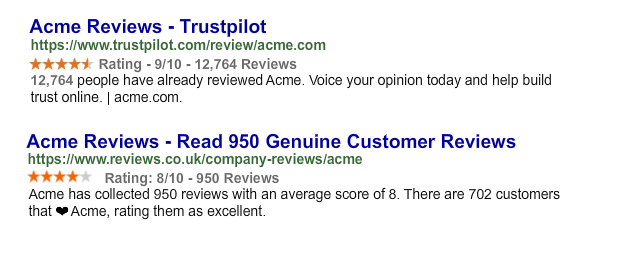
Encouraging Happy Customers to Leave Reviews
There are many, many ways to do this — Emails, personal face-to-face requests, flyers, links on your site, etc. The best tactics for you depend principally on your customers. Assuming you have a score between 4.2 and 4.5 (studies show that this is the sweet spot — below this number is unconvincing and above looks like a cheat), then the number of reviews is the most important factor both for Google and for people.
Knowledge Sites

Most brands do not have a Wikipedia page. Those that do have every right to correct information as long as they can provide references / supporting evidence. The biggest problem Wikipedia has is that articles/statements are provided without supporting evidence from trustworthy third parties.
The ‘article does not cite enough sources’ comment is very common, and that text often appears in SERPs when it is present on the Wikipedia page; this underlines the importance of supporting evidence from accessible, trustworthy third parties on Wikipedia. You have the right to add such sources yourself — just make sure they are trustworthy, authoritative and independent.

You can safely and usefully apply the same wise advice to any information about you that appears online — support with sources when you can. Trustworthiness of the source of information can be seen as ‘the new PageRank.’
If your brand is not notable and does not deserve a Wikipedia page, don’t give up. Look into other knowledge bases such as Crunchbase, Wikidata, DBpedia, etc.; they are unlikely to appear in your SERPs, but are well worth perfecting since they support understanding of your brand by Google and will help them enormously in surfacing factually correct references to your brand in “brand” SERPs.
Partners

Here is a distributor of our products. They have direct control of their site, just like we do. Merely pointing out that this presentation in Google’s results could easily be MUCH better is often enough to get them on board to change improve. Suggest how this presentation could be improved. More likely than not, they will play ball.
With partners, this type of engagement can be taken further. It is in both their interests and yours to have your products presented optimally in Google’s results. You have the expertise. It will help you if you help them.

No Control
Confucious said something along the lines of: identify those things you can influence and work to change them favorably; identify those things you cannot influence and learn to accept them.
One might assume that ‘no control’ falls into the second part of that sage advice. It doesn’t. You cannot control the content of the URL, the page or the presentation of the page in Google’s SERP. However, you can attempt to change it by contacting the author, and if that doesn’t work, you can excerpt strong influence to overpower that result and push it down in the SERP, making it invisible on that all-important initial search.
Articles

The example above is great. The meta title and description are about as good as we could expect. If they weren’t, we could have contacted the journalist to suggest changing the metas. Surprisingly, they often do if the request is tactful, the suggestion you make is positive for them, and it is not excessively glowing about you.
In this case, the date is from 2014, which makes this fantastic article seem less relevant. Here, I would suggest reading the article and finding some information that could usefully be updated — the address of the company, a new award, a cited employee replaced by someone else, for example (avoid touching on the message/points / journalistic style), then contact the journalist and tactfully suggest the update(s). If they do, the date shown in the SERP should be updated, both making it look more relevant in the SERP, but also potentially contributing to pushing it up in the SERP.

And there is more we can do — link to it from a prominent page on your site. That will send a strong signal to Google that it has correctly understood that this excellent article is about you. That increased confidence will help maintain the article’s good position and also potentially contribute to moving it up a place or two in the SERPs. If you have several positive online articles on trustworthy and authoritative sites, create and maintain a press section. And have a system for ensuring that your site gives the most exposure to the positive articles that rank for your Brand SERPs — they will rank just a little bit better thanks to your support.
Unofficial Youtube Channels

The thumbnail makes YouTube videos and channels particularly visible. Add to that the rising importance of video and the fact that Google has a tendency to favor its own subsidiary, YouTube is (or will probably become) an essential and effective part of your Brand SERP strategy. Just like any other social platform, a healthy, active official YouTube channel will tend to outrank anything unofficial. The unofficial example above has the added advantage (from our point of view) of being old, making it easier to dethrone/replace with our healthy, active, regularly updated official channel.

What does a GREAT Brand SERP look like?
Expect to spend a year to get something this good. Here we are showing accurate, consistent and positive information to prospects, investors, partners, clients, journalists, job candidates, readers, subscribers, etc. who search your brand name.
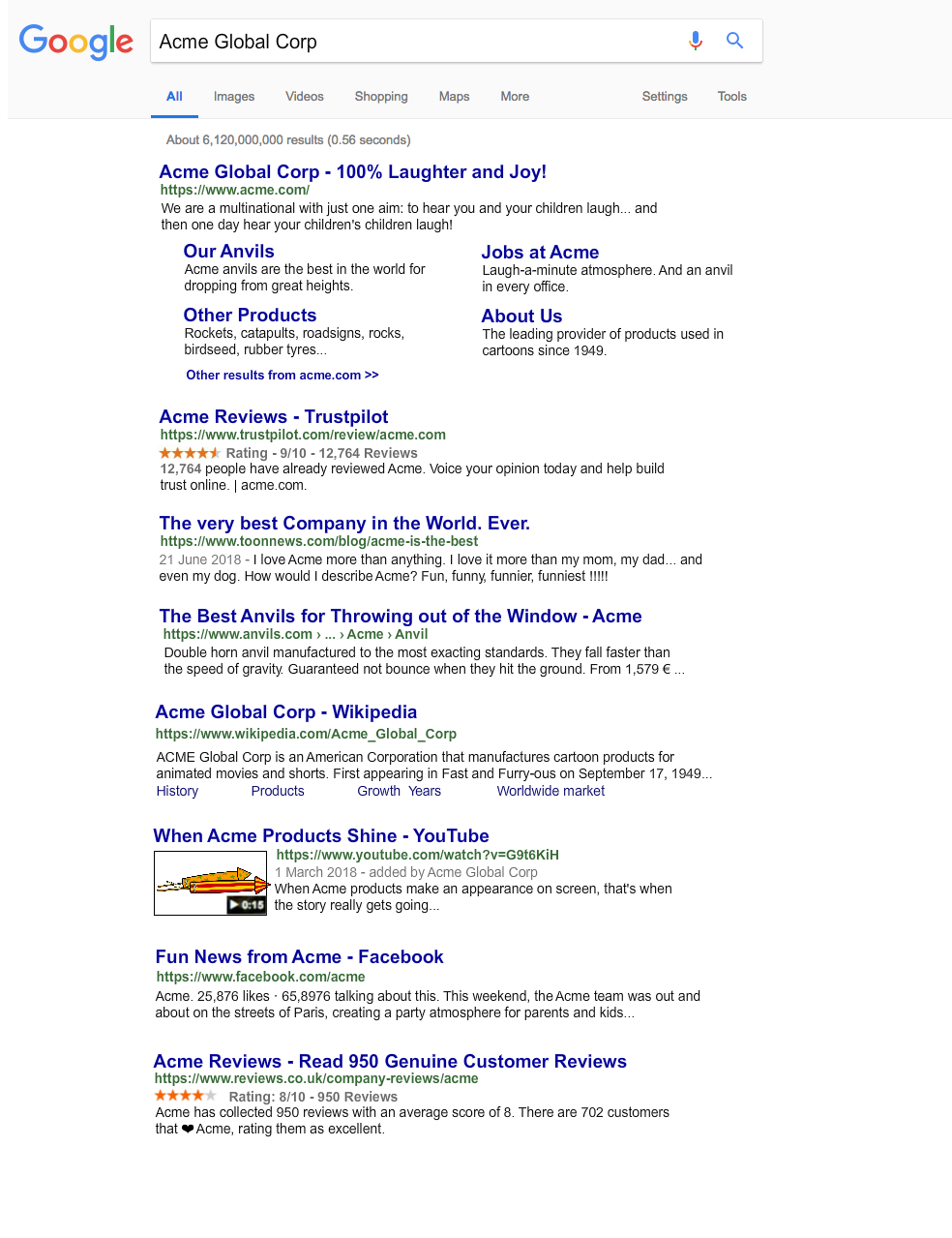
Pro Tip
Knowledge Graph Panel
Getting that knowledge graph panel gives you status. It also means Google has a good, solid understanding of who you are and what you offer and is confident enough to show that to users searching your brand. The trick is to push your brand into the Knowledge Graph as an entity. How to do that will be the topic of another article.
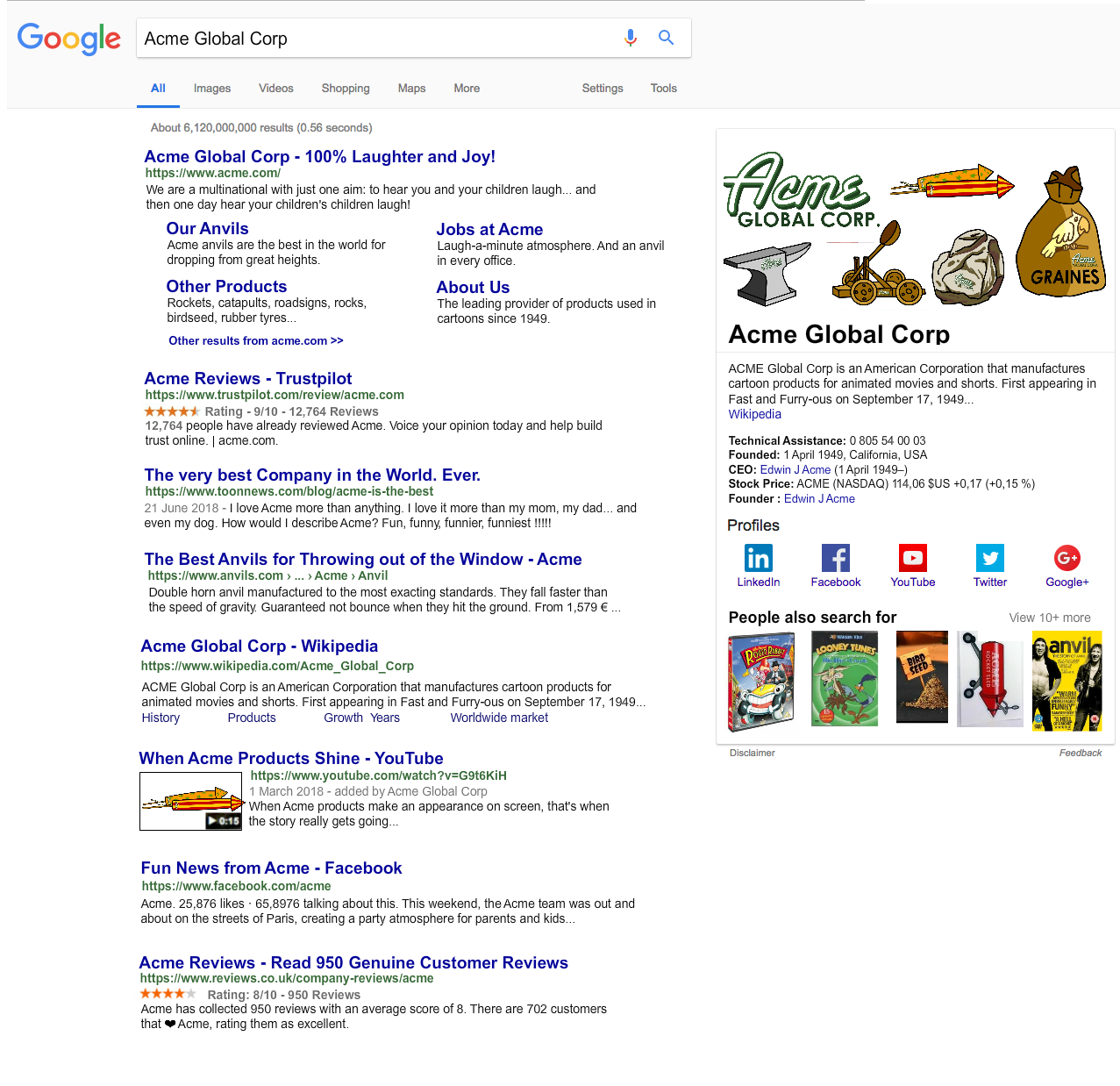
Depending on your situation, that brand SERP knowledge panel is most commonly comprised of one of these:
- My Business listing (local brick and mortar businesses).
- Google Knowledge Graph (larger corporations and famous people).
- A mixture of My Business and the Knowledge Graph (educational establishments and tourist attractions commonly show this).
Two common issues worth noting: A large corporation has a My Business listing in the Knowledge Panel. A brand with an ambiguous name gets a knowledge panel that describes another entity/concept. Correcting those issues is a long and complex process, and well beyond the scope of this article.
ORM
Do not confuse this ongoing proactive brand SERP optimization work with Online Reputation firefighting. ORM firefighting is all about drowning bad press — the approach would tend to be to publish lots of content and sink the results you don’t control.
If you there is no fire around your brand, the ‘drowning’ approach is ineffective, and potentially very damaging. In the context of this article, we are in a situation of ‘perfecting’ your brand SERPs, not firefighting. In this context, it is easier, faster, safer, cheaper, more effective and more efficient to improve existing results and push the positive ones upwards from below.
Focus on overtaking rather than drowning.
Takeaway
Take control. Be proactive. Don’t leave it to luck. Set aside the resources and set out an ongoing strategy to make your Brand SERPs accurate, positive and pertinent to prospects, investors, partners, clients, journalists, job candidates, readers, subscribers, and Google.
This process takes time. It takes application. It needs to be closely monitored. Dealing with each result in your brand SERP is simple when taken in isolation, but the overall picture is complex, volatile, and fundamentally important to your business.
Perfecting your Brand SERPs is a never-ending task of acting, tracking and reacting.
It should be an integral part of your digital strategy.






